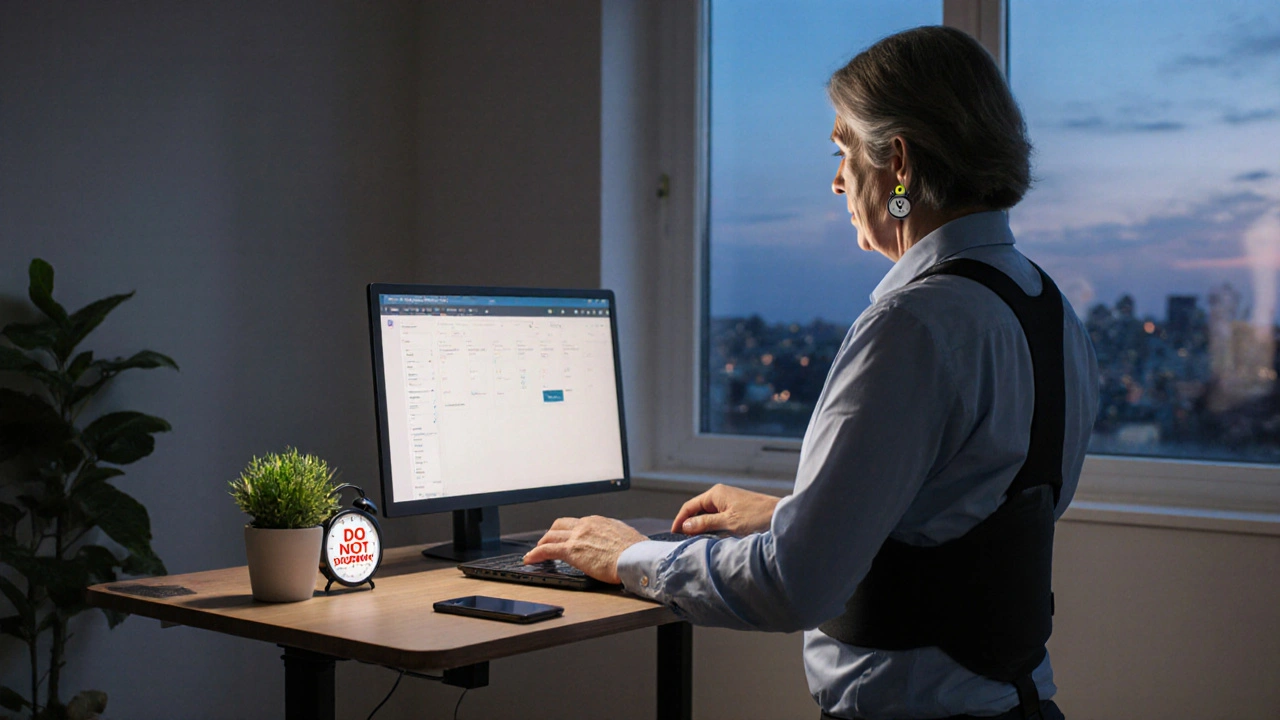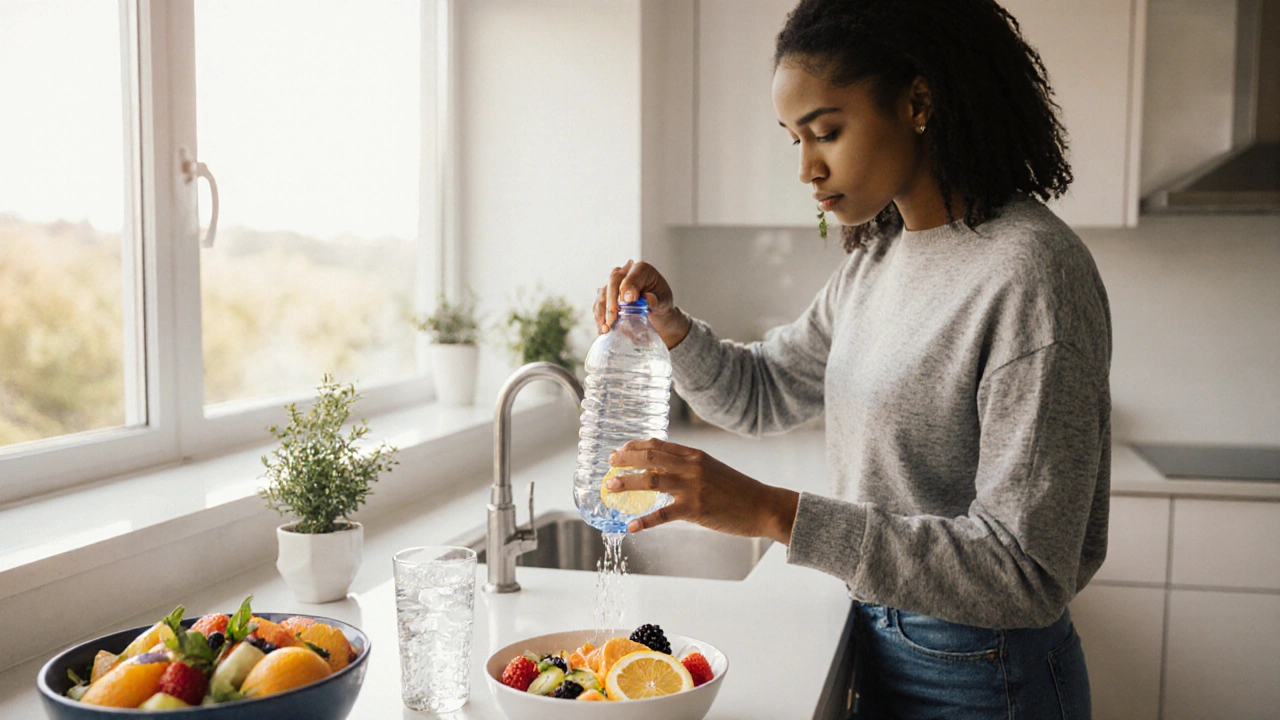Headache Prevention is a proactive approach that minimizes the occurrence and intensity of headaches by adjusting everyday habits such as hydration, sleep quality, and stress management. The goal isn’t a quick fix; it’s a sustainable lifestyle shift you can begin right now.
Why Lifestyle Matters More Than You Think
Research from the British Headache Society shows that up to 80% of tension‑type headaches and 60% of migraines have at least one modifiable trigger. When you address those triggers, you’re not just treating a symptom-you’re tackling the root cause.
1. Stay Properly Hydrated
Dehydration is a state where the body lacks sufficient water to maintain normal physiological functions, and it’s one of the most common headache catalysts. A study by the University of Birmingham found that drinking 2liters of water over a day reduced headache days by 23% among frequent sufferers.
- Aim for 8‑10 glasses (about 2L) of water daily; adjust upward if you exercise or live in a hot climate.
- Carry a reusable bottle and set hourly reminders on your phone.
- Watch for hidden sources of dehydration: excessive coffee, salty snacks, and alcohol.
2. Prioritise Quality Sleep
Sleep Quality refers to the depth and continuity of sleep cycles, especially the restorative REM and deep‑sleep phases.
Adults need 7‑9hours of uninterrupted sleep. A 2023 meta‑analysis linking sleep deprivation to migraine frequency reported a 31% increase in attacks after just two nights of under‑six‑hour sleep.
- Establish a consistent bedtime and wake‑time, even on weekends.
- Dim lights and shut screens at least 30minutes before bed; consider a blue‑light filter.
- Keep the bedroom cool (around 18°C) and free of distracting noises.
3. Manage Stress Effectively
Stress is the body’s physiological response to perceived threats, releasing cortisol and adrenaline that can tense neck muscles and trigger vascular changes.
Mind‑body techniques have solid evidence. A 2022 randomized trial showed that participants practicing 10‑minute daily mindfulness reduced headache intensity by 1.5 points on a 10‑point scale.
- Try guided breathing: inhale for 4seconds, hold 4, exhale 6.
- Schedule short “micro‑breaks” at work to stretch and reset posture.
- Consider journaling or therapy to identify chronic stressors.
4. Optimize Posture and Ergonomics
Posture is the alignment of the spine and neck while sitting, standing, or moving.
Poor ergonomics strain cervical muscles, a frequent source of tension‑type headaches. The Occupational Safety and Health Administration (OSHA) recommends an elbow angle of 90‑100° and a screen top at eye level.
- Adjust chair height so feet rest flat on the floor.
- Use a lumbar roll or rolled towel to maintain natural curve.
- Take a 1‑minute stand‑up stretch every hour.
5. Watch Your Caffeine Intake
Caffeine Intake measures the amount of caffeine consumed from coffee, tea, energy drinks, and certain medications.
While moderate caffeine can relieve early migraine pain, abrupt withdrawal or excess (>400mg/day) often sparks rebound headaches. The NHS advises keeping caffeine under 300mg per day.
- Track caffeine using a simple notebook or phone app.
- Swap one cup of coffee for herbal tea on days you feel jittery.
- Avoid caffeine after 2p.m. to protect sleep quality.

6. Fine‑Tune Nutrition
Nutrition encompasses the intake of macro‑ and micronutrients that sustain brain and vascular health.
Deficiencies in magnesium, riboflavin (vitaminB2), and CoQ10 have been linked to higher migraine risk. A double‑blind study from Manchester University (2021) found that 600mg of magnesium daily cut migraine days by 41%.
- Include leafy greens, nuts, and whole grains for magnesium.
- Consume a serving of dairy or fortified cereals for riboflavin.
- Limit processed meats, aged cheeses, and MSG, common migraine triggers.
7. Incorporate Regular Physical Activity
Exercise is any planned, structured movement that raises heart rate and improves circulation.
A 2020 review showed aerobic exercise three times a week reduced headache frequency by 30% in chronic sufferers.
- Start with 20‑minute brisk walks, cycling, or swimming.
- Include strength training twice weekly to support posture.
- Avoid sudden high‑intensity bursts on days you already feel a headache looming.
8. Reduce Excessive Screen Time
Screen Time refers to the total hours spent looking at digital devices, often causing eye strain and neck tension.
The Vision Council reports that people who take the 20‑20‑20 rule (every 20minutes, look 20feet away for 20seconds) experience 35% fewer tension headaches.
- Set a timer for 20‑minute intervals.
- Adjust monitor brightness to match ambient light.
- Consider blue‑light blocking glasses for evening work.
Quick Reference Comparison
| Factor | Recommended Level | Impact on Headache Risk | Simple Daily Tip |
|---|---|---|---|
| Hydration | ≈2L (8‑10 glasses) | High reduction | Carry a marked water bottle |
| Sleep Quality | 7‑9hrs uninterrupted | Medium‑high | Set a consistent bedtime alarm |
| Stress Management | Daily 10‑min mindfulness | Medium | Use a breathing app during breaks |
| Posture | Neutral spine, elbows 90° | Medium | Adjust chair height, set hourly stretch reminder |
| Caffeine Intake | ≤300mg (≈2 cups coffee) | Low‑medium | Track cups in a notebook |
| Nutrition | Magnesium 400mg, B2 400µg | Low‑medium | Snack on almonds & leafy greens |
| Exercise | 150min moderate per week | Medium | Take a 20‑min walk after lunch |
| Screen Time | ≤2hrs continuous | Low | Apply 20‑20‑20 rule |
Connecting the Dots: How These Changes Interact
Each habit doesn’t exist in a vacuum. For example, adequate hydration supports better sleep, while regular exercise improves stress resilience and posture. Building a holistic routine-instead of isolated fixes-creates a positive feedback loop that dramatically lowers headache frequency.
Next Steps in Your Headache‑Free Journey
Start with a self‑audit: note how many glasses of water you drink, your average bedtime, and your daily caffeine cups. Choose the two factors that score the lowest and implement the tips above for 14days. Track your headache log; many people see noticeable change within a week.
When you feel ready, explore deeper topics such as headache diaries, trigger‑specific elimination diets, or professional physiotherapy for chronic neck tension. Those are natural extensions of the lifestyle foundation you’ve just built.

Frequently Asked Questions
How much water should I really drink to prevent headaches?
Aim for roughly 2liters (8‑10 glasses) spread evenly throughout the day. If you exercise, sweat heavily, or live in a warm climate, add an extra 500ml for each hour of intense activity.
Can I still have coffee if I’m trying to prevent migraines?
Yes-moderation is key. Keep caffeine below 300mg per day (about two standard cups of coffee). Gradually reduce intake if you notice rebound headaches when you skip a cup.
What’s the best posture setup for a home office?
Your monitor should sit at eye level, shoulders relaxed, elbows at 90‑100°, and feet flat on the floor. Use a lumbar roll if your chair lacks lower‑back support, and stand up to stretch every hour.
Are there specific foods that trigger headaches?
Common culprits include aged cheeses, processed meats, chocolate, and foods high in MSG or artificial sweeteners. Keeping a simple food diary for two weeks helps pinpoint personal triggers.
How often should I exercise to see a benefit?
Aim for at least 150minutes of moderate aerobic activity per week (like brisk walking or cycling) plus two days of strength training. Consistency beats intensity for headache prevention.







Julius Smith
September 26, 2025 AT 19:35Dude, you can’t just tell people to drink water and expect miracles 😂
Brittaney Phelps
October 7, 2025 AT 05:35Love the practical vibe-tiny tweaks add up fast! Start with a water bottle you actually like, and you’ll notice the difference.
Kim Nguyệt Lệ
October 17, 2025 AT 15:35The article correctly emphasizes hydration, but the phrase “2liters” should include a space (“2 liters”) for clarity. Also, “8‑10 glasses” is more reader‑friendly than “8‑10 glasses (about 2L)”. Overall, solid evidence‑based advice.
Rhonda Adams
October 28, 2025 AT 00:35Hey Julius, totally get your frustration, but many folks actually do benefit from simple reminders. Keep the emojis coming-makes the tip feel less clinical! 😊
Macy-Lynn Lytsman Piernbaum
November 7, 2025 AT 10:35When you look at these lifestyle hacks as a mini‑experiment rather than a strict regime, the whole process feels a lot less intimidating. Hydration, sleep, stress, posture, caffeine, nutrition, exercise, and screen habits are all interconnected gears in the same machine.
For instance, proper water intake helps regulate body temperature, which in turn improves sleep quality because you’re less likely to wake up thirsty. Better sleep reduces cortisol spikes, so you’re calmer during the day and less prone to tension‑type headaches.
If you’ve ever noticed that a late night of scrolling makes your neck ache, you now have a physiological explanation. Mind‑body practices such as a 10‑minute breathing exercise can reset that nervous system overload within minutes. Adding magnesium‑rich foods like spinach or almonds not only supports muscle relaxation but also feeds the brain’s energy factories.
Caffeine is a double‑edged sword: a modest cup can be a quick painkiller, yet skipping it abruptly can trigger a rebound headache. That’s why the article wisely suggests tracking caffeine and tapering it gradually if you decide to cut back. Posture tweaks-like keeping your monitor at eye level and taking a 1‑minute stretch every hour-spare the neck muscles from chronic strain.
And the 20‑20‑20 rule for screen time isn’t just eye‑care fluff; it forces you to move, which boosts circulation to the scalp. Regular aerobic activity, even a brisk 20‑minute walk, pumps fresh oxygenated blood to the brain, easing vascular tension. Strength training adds a supportive scaffold for your spine, making you less vulnerable to the slouch‑induced headaches that office workers love to complain about.
The beauty of this holistic approach is the positive feedback loop: each habit reinforces the others, creating a compounding protective effect. Start with two changes that feel easiest-maybe a water bottle and a consistent bedtime-track your headache log, and adjust as you go. You’ll likely be surprised how quickly the frequency drops, proving that small, sustainable steps truly beat quick‑fix pills. 😊
Alexandre Baril
November 17, 2025 AT 20:35One practical tip: set a phone alarm for hydration and another for a quick stretch; the reminders become habit cues without any extra mental load.
Stephen Davis
November 28, 2025 AT 06:35Whoa, that cascade you described is like a domino effect-knocking over one piece sets the whole chain moving. I love the colourful language; makes the science feel alive!
Grant Wesgate
December 8, 2025 AT 16:35Honestly, I’ve tried the 20‑20‑20 rule and it actually reduces eye strain. Small breaks keep the mind fresh, too! 😎
Richard Phelan
December 19, 2025 AT 02:35Really? You’d think a piece that calls out “2liters” would be flawless, yet the tiniest formatting slip feels like an insult to our intellect! Let’s demand perfection in every bullet.